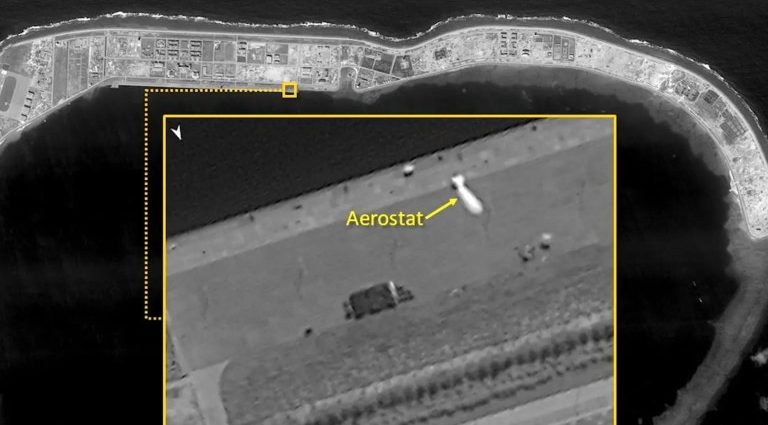China could soon regularly deploy high-altitude airships over the contested South China Sea for intelligence, surveillance and reconnaissance (ISR), missile early warning and potentially target acquisition for anti-access/area denial (A2/AD) weapons.
This week, The Warzone reported that China may have deployed a high-altitude, long-range airship around the vicinity of Luzon in the northern Philippines.
Photos posted on Facebook and reported by The Warzone show a translucent blimp-shaped object photographed from Pangasinan in the Philippines, which faces the northern areas of the South China Sea.
The images, which have since been deleted or blocked from public view but are still available here in Philippine media, show that the object has transparent or reflective skin, a common feature in many high-altitude balloons.
The Warzone notes that the airship resembles two high-altitude, uncrewed solar-powered Chinese balloons, the Tian Heng and Yuan Meng. The source notes that these balloons are intended for stratospheric operations at 7,000 to 20,000 meters.
It also mentions that little is known about these projects and that it is unclear what payload the apparent balloon-like airship was carrying when it was photographed near the Philippines.
It would not have been the first time that China’s observation balloons were spotted in the South China Sea. In December 2019, The National Interest reported that China had deployed aerostats over Mischief Reef to provide continuous situational awareness around the occupied feature.
These deployments may be part of China’s more extensive plans to build an aerostat network over hotspots such as the Himalayas, South China Sea and Taiwan Strait.
In the same month, South China Morning Post (SCMP) noted that China has been building such a network since 2017, with its aerostats fitted with large phased-array radars that can monitor airborne and surface targets within a 300-kilometer radius.

China may have taken note of the advantages of aerostats versus other ISR platforms such as satellites, drones and spy planes.
A 2010 study by the Federation of American Scientists lists these advantages over terrestrial and space-based sensors, which include sizeable early warning surveillance areas but not as big as those of satellites, high survivability due to minimal radar returns, operating altitude beyond the range of most combat aircraft and air defenses, persistent ‘stare’ surveillance capability, and low operating costs as one aerostat costs US$100,000 for initial development and operations compared to US$1.6 billion for one infrared satellite.
China is hardly the first state to deploy aerostats. Asia Times has previously reported on the US Covert Long-Dwell Stratospheric Architecture (COLD STAR) and Joint Land Attack Cruise Missile Elevated Netted Sensor System (JLENS) aerostat projects, which aim to plug platform gaps in US missile defenses against incoming cruise missiles and hypersonic weapons.
Regarding missile defense, aerostats feature persistent presence, look-down angles to spot incoming cruise missiles, lower costs than satellites and better survivability than terrestrial sensors.
Their effectiveness against low-flying targets is not affected by the Earth’s curvature. Their operators can also deploy them in more significant numbers to ensure redundancy and survivability. Aerostats also carry a wider variety of payloads.
China may need to bolster its missile early warning system against low-flying cruise missile threats from Taiwan. Asia Times has previously reported on Taiwan’s covert cruise missile projects, which can strike major Chinese cities such as Beijing and Shanghai.
Given the threat Taiwan’s cruise missiles pose to China’s strategic military, government and civilian infrastructure, China may be trying to improve its defenses against low-flying cruise missiles by establishing an aerostat network.
Apart from missile defense, China’s aerostats may have targeting and fire control capability linked with its surface-to-air missile launchers on its occupied South China Sea features.
The US JLENS has a similar ability, as it could be integrated with SM-6 and Patriot missile interceptors. Such a capability would strengthen China’s A2/AD capabilities in the contested waters.
China may find further uses for aerostat technology. In a 2015 article in National Defense Magazine, Stew Magnusson writes that aerostats can be used as mobile airborne communication nodes while noting their vulnerability in A2/AD environments.
US defense contractor Lockheed Martin has been developing models that can fly above the jet stream at 8,200 to 9,000 meters to minimize their vulnerability. Likewise, China may be exploring this possibility with its aerostat research.

Magnusson notes that aerostats in the form of airships can be used to ferry cargo, noting that airships can transport more material than a cargo plane but at slower speeds. He mentions that this capability may help deliver large cargo payloads in hard-to-access areas.
Magnusson states that airships eliminate the risk of casualties and disruptions when trucking cargo inland after arriving in airports or seaports.
At the same time, he notes that airships suffer from ballast exchange problems, noting that an equal amount of weight must replace the offloaded weight to prevent the airship from floating uncontrollably away.

